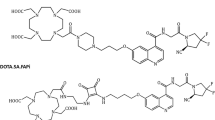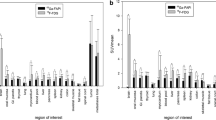Abstract
Purpose
[68Ga]Ga-FAPI PET/CT has been widely used in clinical diagnosis and radiopharmaceutical therapy. In this study, tumor-to-blood ratio (TBR) was evaluated as a powerful tool for semiquantitative assessment of [68Ga]Ga-FAPI-04 tumor uptake and as an effective index for tumors with high FAP expression in theranostics.
Methods
Nine patients with pancreatic cancer underwent a 60-min dynamic PET/CT scan by total-body PET/CT (with a long AFOV of 194 cm) after injection of [68Ga]Ga-FAPI-04. After dynamic PET/CT scan, three patients received chemotherapy and underwent the second dynamic scan to evaluate treatment response. Time-activity curves (TACs) were obtained by drawing regions of interest for primary pancreatic lesions and metastatic lesions. The lesion TACs were fitted using four compartment models by the software PMOD PKIN kinetic modeling. The preferred pharmacokinetic model for [68Ga]Ga-FAPI-04 was evaluated based on the Akaike information criterion. The correlations between simplified methods for quantification of [68Ga]Ga-FAPI-04 (SUVs; tumor-to-blood ratios [TBRs]) and the total distribution volume (Vt) estimates obtained from pharmacokinetic analysis were calculated.
Results
In total, 9 primary lesions and 25 metastatic lesions were evaluated. The reversible two-tissue compartment model (2TCM) was the most appropriate model among the four compartment models. The total distribution volume Vt values derived from 2TCM varied significantly in pathological lesions and background regions. A strong positive correlation was observed between TBRmean and Vt from the 2TCM model in pathological lesions (R2=0.92, P<0.001). The relative difference range for TBRmean was 2.1% compared to the reduction rate of Vt in the patients who were treated with chemotherapy.
Conclusions
A strong positive correlation was observed between TBRmean and Vt for [68Ga]Ga-FAPI-04. TBRmean reflects FAP receptor density better than SUVmean and SUVmax, and would be the preferred measurement tool for semiquantitative assessment of [68Ga]Ga-FAPI-04 tumor uptake and as a means for evaluating treatment response.




Similar content being viewed by others
Data availability
The data could be obtained from the corresponding author upon request.
References
Xia N, Yang N, Shan Q, et al. HNRNPC regulates RhoA to induce DNA damage repair and cancer-associated fibroblast activation causing radiation resistance in pancreatic cancer. J Cell Mol Med. 2022;26:2322–36.
Ogawa Y, Masugi Y, Abe T, et al. Three distinct stroma types in human pancreatic cancer identified by image analysis of fibroblast subpopulations and collagen. Clin Cancer Res. 2021;27:107–19.
Shi M, Yu DH, Chen Y, et al. Expression of fibroblast activation protein in human pancreatic adenocarcinoma and its clinicopathological significance. World J Gastroenterol. 2012;18:840–6.
Lindner T, Loktev A, Altmann A, et al. Development of quinoline-based theranostic ligands for the targeting of fibroblast activation protein. J Nucl Med. 2018;59:1415–22.
Loktev A, Lindner T, Mier W, et al. A tumor-imaging method targeting cancer-associated fibroblasts. J Nucl Med. 2018;59:1423–9.
Rohrich M, Naumann P, Giesel FL, et al. Impact of (68)Ga-FAPI PET/CT Imaging on the therapeutic management of primary and recurrent pancreatic ductal adenocarcinomas. J Nucl Med. 2021;62:779–86.
Zhang Z, Jia G, Pan G, et al. Comparison of the diagnostic efficacy of (68) Ga-FAPI-04 PET/MR and (18)F-FDG PET/CT in patients with pancreatic cancer. Eur J Nucl Med Mol Imaging. 2022; 49:2877–88.
Baum RP, Schuchardt C, Singh A, et al. Feasibility, biodistribution, and preliminary dosimetry in peptide-targeted radionuclide therapy of diverse adenocarcinomas using (177)Lu-FAP-2286: first-in-humans results. J Nucl Med. 2022;63:415–23.
Ilan E, Velikyan I, Sandstrom M, Sundin A, Lubberink M. Tumor-to-blood ratio for assessment of somatostatin receptor density in neuroendocrine tumors using (68)Ga-DOTATOC and (68)Ga-DOTATATE. J Nucl Med. 2020;61:217–21.
Gabriel M, Oberauer A, Dobrozemsky G, et al. 68Ga-DOTA-Tyr3-octreotide PET for assessing response to somatostatin-receptor-mediated radionuclide therapy. J Nucl Med. 2009;50:1427–34.
Haug AR, Auernhammer CJ, Wangler B, et al. 68Ga-DOTATATE PET/CT for the early prediction of response to somatostatin receptor-mediated radionuclide therapy in patients with well-differentiated neuroendocrine tumors. J Nucl Med. 2010;51:1349–56.
Gunn RN, Gunn SR, Cunningham VJ. Positron emission tomography compartmental models. J Cereb Blood Flow Metab. 2001;21:635–52.
Ding W, Yu J, Zheng C, et al. Machine Learning-based noninvasive quantification of single-imaging session dual-tracer (18)F-FDG and (68)Ga-DOTATATE dynamic PET-CT in oncology. IEEE Trans Med Imaging. 2022;41:347–59.
Liu M, Paranjpe MD, Zhou X, et al. Sex modulates the ApoE epsilon4 effect on brain tau deposition measured by (18)F-AV-1451 PET in individuals with mild cognitive impairment. Theranostics. 2019;9:4959–70.
Zhao Q, Chen X, Zhou Y. Quantitative multimodal multiparametric imaging in Alzheimer's disease. Brain Inform. 2016;3:29–37.
Zhou Y, Ye W, Brasic JR, Wong DF. Multi-graphical analysis of dynamic PET. Neuroimage. 2010;49:2947–57.
Zhou Y, Endres CJ, Brasic JR, Huang SC, Wong DF. Linear regression with spatial constraint to generate parametric images of ligand-receptor dynamic PET studies with a simplified reference tissue model. Neuroimage. 2003;18:975–89.
Lang M, Spektor AM, Hielscher T, et al. Static and dynamic (68)Ga-FAPI PET/CT for the detection of malignant transformation of intraductal papillary mucinous neoplasia of the pancreas. J Nucl Med. 2022. https://doi.org/10.2967/jnumed.122.264361.
Zhang X, Xie Z, Berg E, et al. Total-body dynamic reconstruction and parametric imaging on the uEXPLORER. J Nucl Med. 2020;61:285–91.
Innis RB, Cunningham VJ, Delforge J, et al. Consensus nomenclature for in vivo imaging of reversibly binding radioligands. J Cereb Blood Flow Metab. 2007;27:1533–9.
Koopman T, Verburg N, Schuit RC, et al. Quantification of O-(2-[(18)F]fluoroethyl)-L-tyrosine kinetics in glioma. EJNMMI Res. 2018;8:72.
Ringheim A, Campos Neto GC, Anazodo U, et al. Kinetic modeling of (68)Ga-PSMA-11 and validation of simplified methods for quantification in primary prostate cancer patients. EJNMMI Res. 2020;10:12.
Slaets D, De Vos F. Comparison between kinetic modelling and graphical analysis for the quantification of [18F]fluoromethylcholine uptake in mice. EJNMMI Res. 2013;3:66.
Dendl K, Schlittenhardt J, Staudinger F, et al. The role of fibroblast activation protein ligands in oncologic PET imaging. PET Clin. 2021;16:341–51.
Coughlin JM, Slania S, Du Y, et al. (18)F-XTRA PET for enhanced imaging of the extrathalamic alpha4beta2 nicotinic acetylcholine receptor. J Nucl Med. 2018;59:1603-1608.
Iqbal R, Kramer GM, Frings V, et al. Validation of [(18)F]FLT as a perfusion-independent imaging biomarker of tumour response in EGFR-mutated NSCLC patients undergoing treatment with an EGFR tyrosine kinase inhibitor. EJNMMI Res. 2018;8:22.
Pure E, Blomberg R. Pro-tumorigenic roles of fibroblast activation protein in cancer: back to the basics. Oncogene. 2018;37:4343–57.
Kilvaer TK, Khanehkenari MR, Hellevik T, et al. Cancer associated fibroblasts in Stage I-IIIA NSCLC: prognostic impact and their correlations with tumor molecular markers. PLoS ONE. 2015;10:e0134965.
Funding
The study was supported by National Key R&D Program of China (No. 2021YFA0910004); National Natural Science Foundation of China (No. 82171972); Clinical Research Project of Health Industry of Shanghai Municipal Health Commission (20214Y0438); and Nurture projects for the Youth Medical Talents-Medical Imaging Practitioners Program (SHWRS(2021)_099).
Author information
Authors and Affiliations
Corresponding authors
Ethics declarations
Ethics approval
The study involving human participants was in line with the principles of the ethics committee in Renji hospital and the declaration of Helsinki in 1964. Animal-based research was not included in this study.
Consent to participate
The informed consent was waived.
Consent for publication
Not applicable.
Conflict of interest
The authors declare no competing interests.
Additional information
Publisher’s note
Springer Nature remains neutral with regard to jurisdictional claims in published maps and institutional affiliations.
This article is part of the Topical Collection on Oncology - Digestive tract
Supplementary information
ESM 1
The maximum intensity projection of dynamic reconstructed images with 92 frames. The animation lasts 92 seconds, and each second represents one frame. (DOCX 5382 kb)
Rights and permissions
Springer Nature or its licensor (e.g. a society or other partner) holds exclusive rights to this article under a publishing agreement with the author(s) or other rightsholder(s); author self-archiving of the accepted manuscript version of this article is solely governed by the terms of such publishing agreement and applicable law.
About this article
Cite this article
Chen, R., Yang, X., Yu, X. et al. Tumor-to-blood ratio for assessment of fibroblast activation protein receptor density in pancreatic cancer using [68Ga]Ga-FAPI-04. Eur J Nucl Med Mol Imaging 50, 929–936 (2023). https://doi.org/10.1007/s00259-022-06010-5
Received:
Accepted:
Published:
Issue Date:
DOI: https://doi.org/10.1007/s00259-022-06010-5




